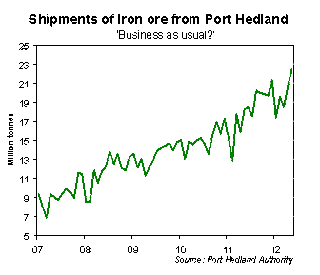From Alvin Pontoh at TD Securities:
Ports data as ‘leading indicator’ of exports
Cargo stats from Western Australia’s Port Hedland (~ 50% of the iron ore trade) reveal no unusual trends in export volumes (see Chart). In the year to May, iron ore shipped out of Port Hedland increased by 24%, a good result by any measure. In fact, May was a record high month, seeing a total of 22.5mn tonnes of iron ore shipments, up 9% m/m.
With the global seaborne iron ore trade rapidly shifting from quarterly contracts to spot (about 80% of the trade are now based on spot), market prices should filter through much faster to the official trade numbers than before.
If that is so, then estimating the nominal value of iron ore exports should be a matter of multiplying volumes by the prevailing spot price. We do precisely that, and compare our results with the official ABS data. Lo and behold, we find an almost perfect relationship between the two measures. As ports data are published well ahead of the official exports data, the former provides an excellent leading indicator of the latter. As the Chart above shows, in May, it appears that the lift in volumes was just offset by lower prices, leaving nominal values unchanged.
China imports data point to upside
Our other favourite gauge of Australia’s iron ore exports comes from China’s statistical bureau. On that front, the news is even more encouraging: China’s imports from Australia jumped 11% m/m in May (though a breakdown by type is not available).
The upshot is there are no alarm bells yet that point to a sudden drop in Chinese iron ore demand. Should the trade position record another deficit next week, it will be because of higher imports, not a sign of external weakness. But given the recent flurry of reports about China’s slowing economy and falling steel demand, iron ore cargo is one indicator we’ll be watching very closely in the coming weeks.
Real-time, stream-of-consciousness insights on financial markets, economics, policy, housing, politics, and anything else that captures my interest. Tweet @cjoye
The author has been described by News Ltd as an "iconoclast", "Svengali", a pollie's "economist muse", and "pungently accurate". Fairfax says he is a "Renaissance man" and "one of Australia’s most respected analysts." Stephen Koukoulas concludes that he is "85% right", and "would make a great Opposition leader." Terry McCrann claims the author thinks "‘nuance’ is a trendy village in the south of France", but can be "scintillating" when he thinks "clearly". The ACTU reckons he’s "an enigma wrapped in a Bloomberg terminal, wrapped in some apparently well-honed abs."


